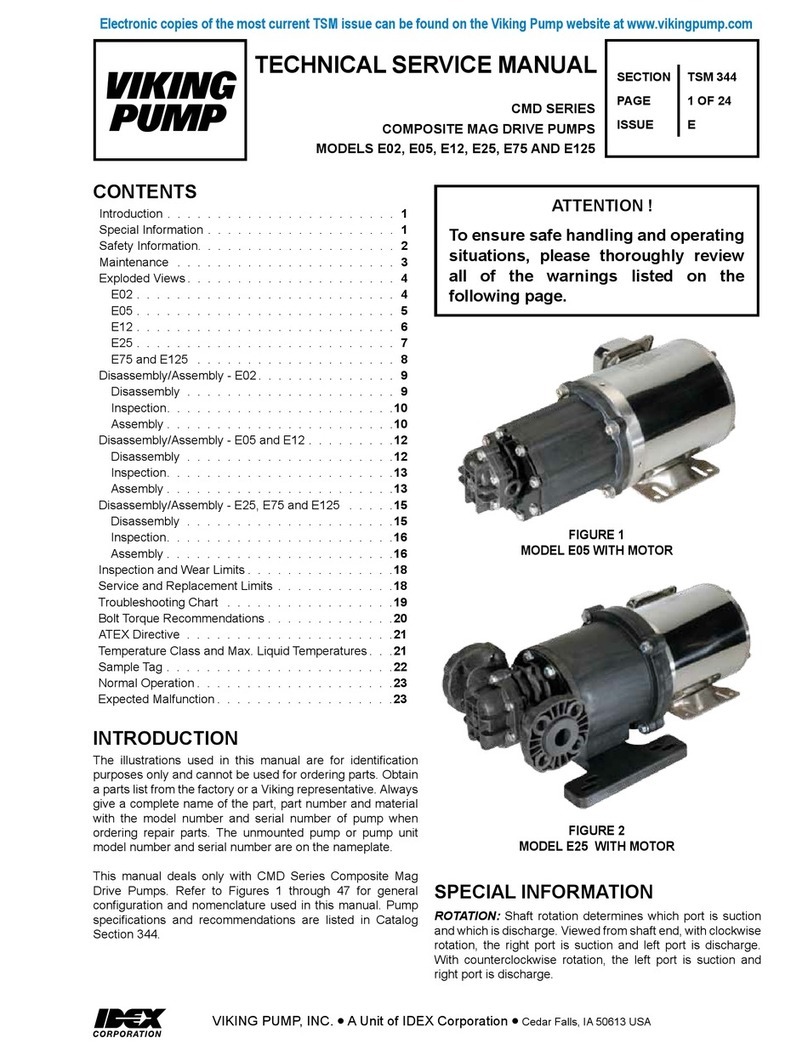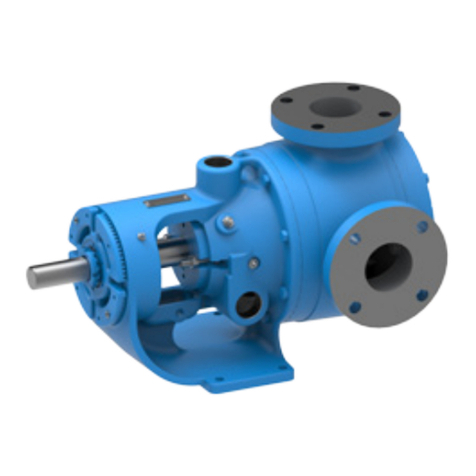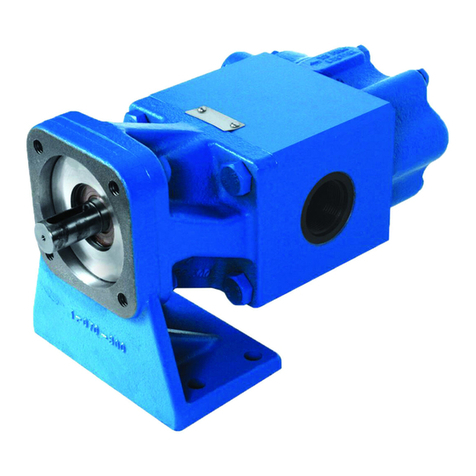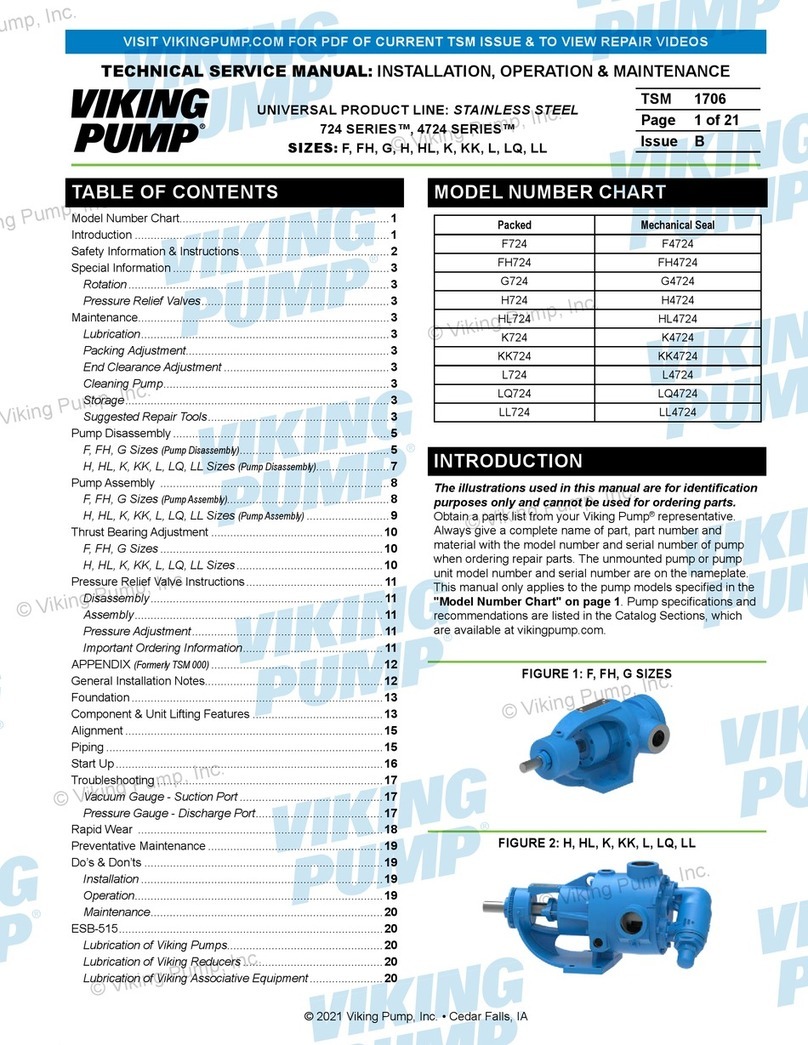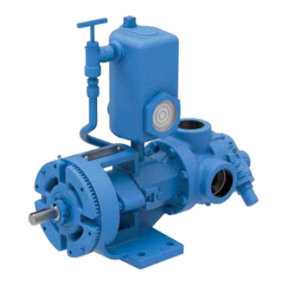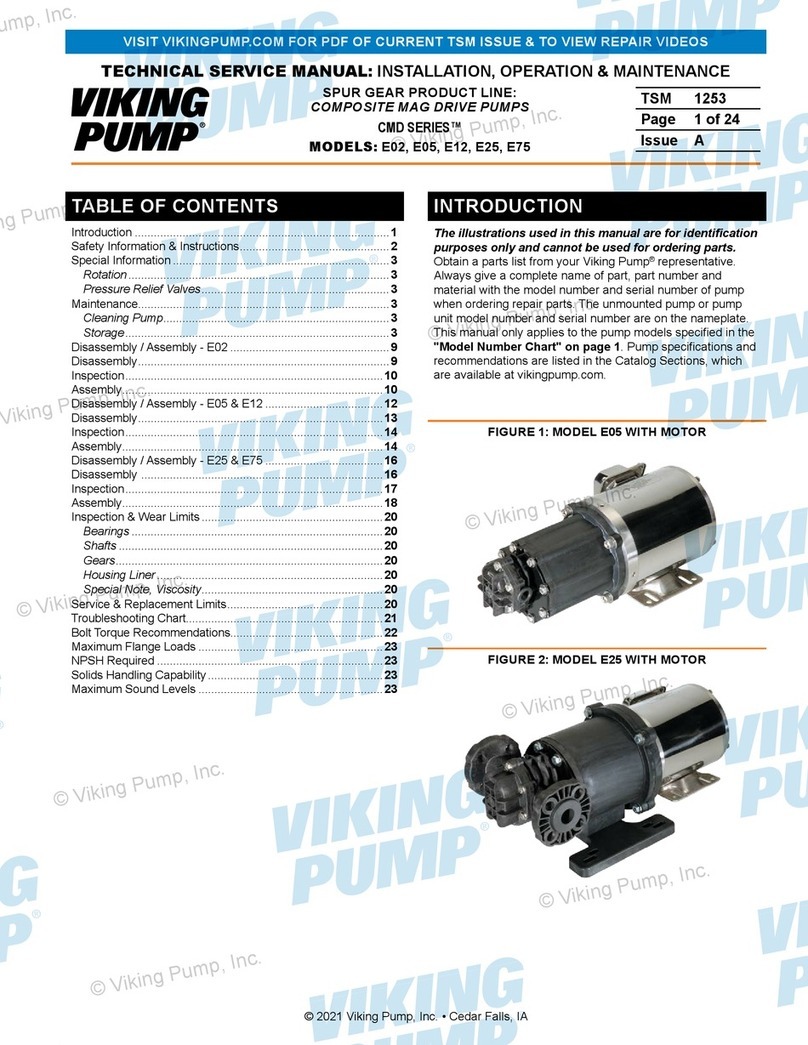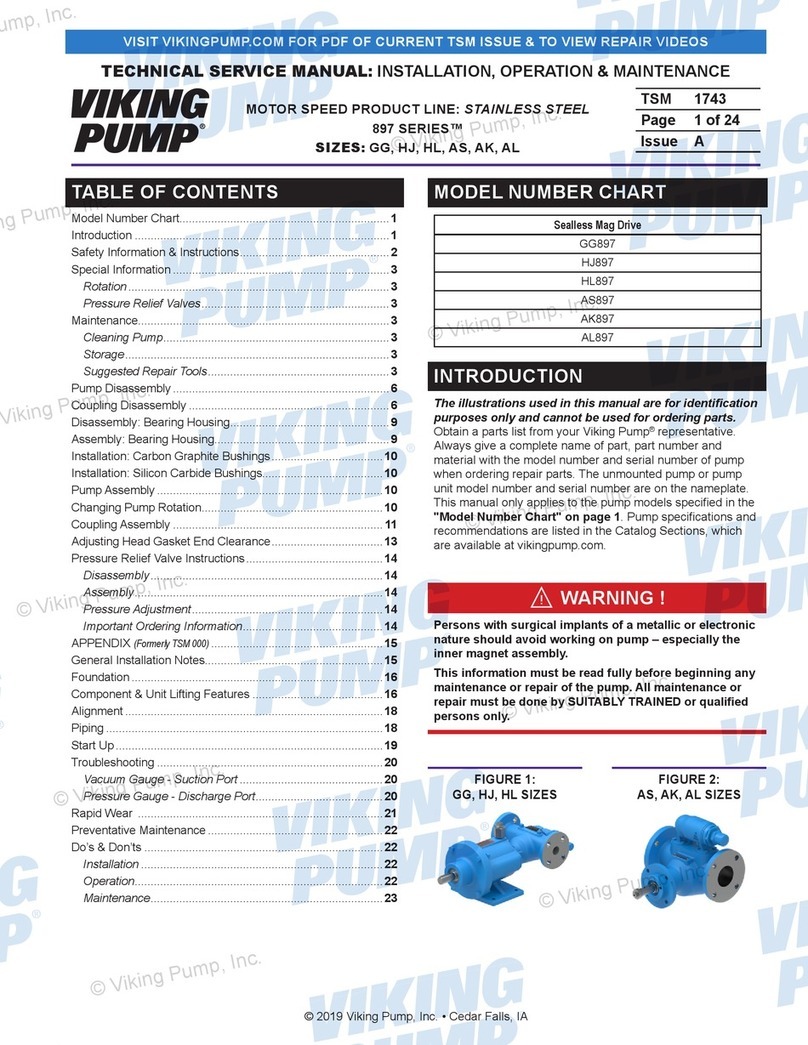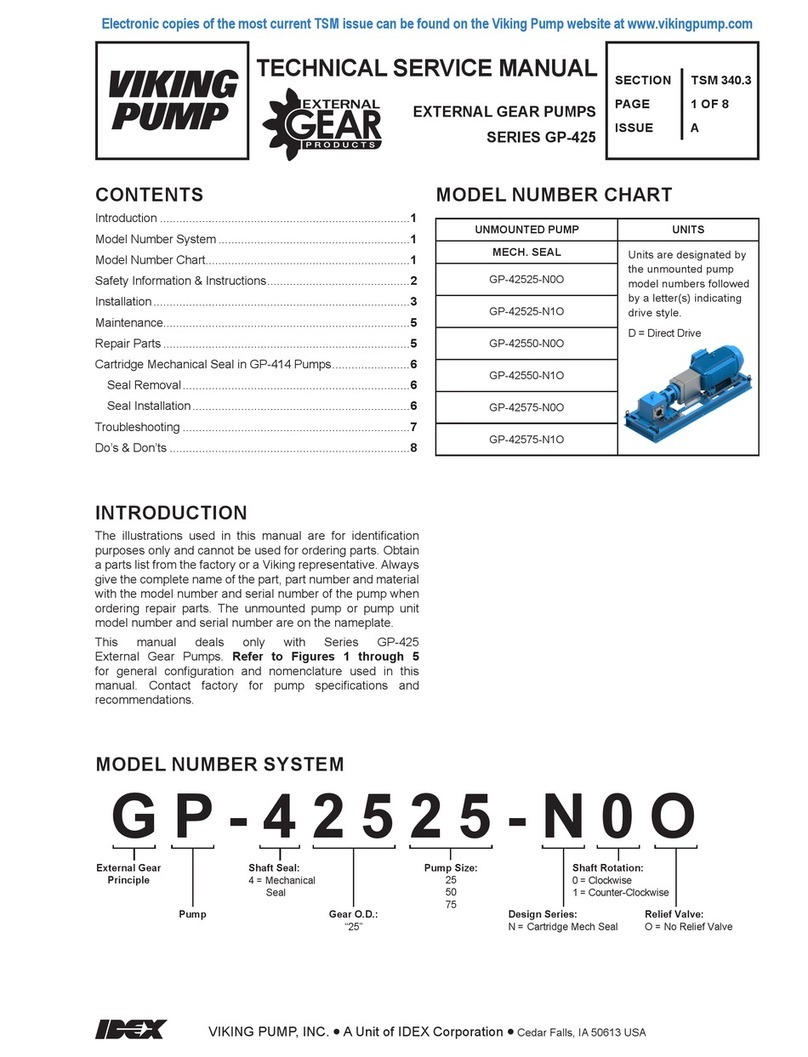
NOTE: Thrust bearing (Item 9) will remain in the seal
holder (Item 6). These need to be removed prior to
reassembly. Also, the stationary seat of the seal will
be left on the shaft and kept there by the retaining ring
(Item 16). The stationary seat is a slip-t into the seal
holder. The only resistance to its removal will come
from the O-ring on the O.D. on the stationary seat.
6. Using snap ring pliers remove the retaining ring (Item
16) from the driver shaft (Item 12) that locates the thrust
bearing.
7. The mechanical seal is made up of two primary components
or parts. The part closest to the shaft end of the pump is the
stationary seat. The part furthest in is the rotating element.
With the retaining ring removed the stationary seat can be
removed from the assembly. Remove the seal face element
from the rotating part if still attached. Then use a pair of
picks to reach into the seal chamber to hook the seal spring
and pull the mechanical seal out.
8. Remove seal washer (Item 8A).
NOTE: This is a bellows type of seal and the bellows
is designed to grip the shaft to drive the rotating part.
It may take some eort to pull the seal out. If the seal
cannot be moved, use a piece at least 6” long of 1” PVC
pipe to push the rotating part down the shaft and into
the pump to break the grip of the bellows on the shaft.
Then use the picks to pull the mechanical seal out.
SEAL INSTALLATION
1. If the pump has not been completely disassembled
and only the seal is being replaced, the rst step after
removing the old seal is to use a lint-free towel to clean the
shaft and the seal chamber inside the pump. Remove any
dirt, sand or dirty oil that has collected in this area. Also
clean the counter-bore where the seal holder O-ring (Item
7) is located.
2. Remove the old stationary seal face from the seal holder
seat (Item 6). The stationary seat is a slip-fit into the seal
holder. The only resistance to its removal will come from
the O-ring on the O.D. on the stationary seat.
3. Remove (8) ¼” socket head capscrews (Item 9B) with
3/16” Allen wrench.
4. Remove end cap (Item 9A), then remove thrust bearing
(Item 9) from seal holder (Item 6).
5. Once the stationary seat and thrust bearing have been
removed, clean the I.D. and O.D. of the seal holder.
6. To install the new stationary seal face, first lubricate the
O-ring on the stationary seat with a generous amount of
temporary assembly lubricant such as P-80®or equivalent.
Also lubricate the bore for the stationary seat. Second,
align the notch in the stationary seat with the pin in the
seal holder (Item 6), use your thumbs or the heel of your
hand to press the stationary seat into bore of the seal
holder (Item 6). Remember the face of the stationary seat
has been lapped to a mirror finish. Any damage done
to this face during installation will affect the ability of the
mechanical seal to properly seal.
7. If needed, install retaining ring (Item 10) into groove in
drive shaft.
⚠CAUTION !
Be careful not to scratch the shaft in the sealing area.
8. Install seal washer (Item 8A) against retaining ring (Item
10).
9. Coat drive shaft (Item 12), tapered installation sleeve
and inner diameter of mechanical seal (Item 8) with a
temporary assembly lubricant such as P-80®or equivalent
before assembly.
NOTE: The recommended lubricants for elastomeric
bellows are soft hand soap and water, or glycerin;
do not use washing-up liquid, liquid soaps, or hand
cleaning gels. Light mineral oil may be used sparingly
with most elastomers. Do not use grease (including
silicone grease) on any elastomer bellows.
10.Slide the rotating part of mechanical seal (Item 8) over
installation sleeve on shaft, against seal washer (Item
8A), making sure the seal spring is fully seated within the
spring guide. Clean the seal faces of any oils or dirt by
rinsing the seal faces off with a suitable cleaner such as
denatured alcohol prior to installation of the seal holder
(Item 6).
11. Lubricate O-ring (Item 7) with a light oil and place on to
seal holder (Item 6). Install seal holder into pump bracket
(Item 1).
12.Add anti-seize to threads and hand tighten the (4) 7/16”
socket head capscrews (Item 6A) with 3/8” Allen wrench to
fasten seal holder (Item 6) to bracket (Item 1). Tighten in a
star pattern the (4) 7/16” socket head capscrews (Item 6A)
with 3/8” Allen wrench to 120 in-lbs.
13.Install retaining ring (Item 16) into groove on shaft.
⚠CAUTION !
Be careful not to scratch the shaft in the sealing area.
14.Slide thrust bearing (Item 9) on to shaft until it contacts
retaining ring (Item 16).
NOTE: The bearing must be installed with the large
side of the inner race against the retainer ring. The
letters on the bearing outer race will be readable when
installed correctly.
15.Install end cap (Item 9A) to seal holder (Item 6) with (8) ¼”
socket head capscrews (Item 9B) with 3/16” Allen wrench
hand tight. The capscrews will be torqued to a final value
later.
16.Install beveled retaining ring (Item 2) with the bevel
facing outward towards the motor end of the driver shaft
(Item12).
NOTE: The driver shaft (Item 12) may need to be
pulled toward the outside of the pump, compressing
the mechanical seal spring to uncover the groove
in the shaft for the beveled retaining ring. Verify the
beveled retaining ring is fully seated
17.Tighten in a star pattern the (8) ¼” socket head capscrews
(Item 9B) with 3/16” Allen wrench to 96 in-lbs.
P-80®is a registered trademark of International Products Corporation
TSM 1655 |Issue A |Page 8 of 15 © 2020 Viking Pump, Inc. • Cedar Falls, IA


